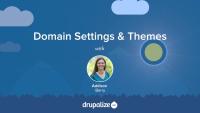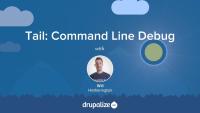Before we can start building a search application we need some sample data that we can index and use for testing, not to mention a site we can use to test this all out on. In this tutorial we'll walk through installing Drupal 7 and importing some sample data.
In order for this to work I built a Drupal 7 site with a content type named Fish, and then imported a whole bunch of descriptions of various fish from Wikipedia. You should be able to use the provided database dump in order to get up and running with a sample Drupal site pre-populated with some sample data.
If you're not planning on following along and building the fish finder application in the Search API and Solr series, or are planning on implementing Solr search on your own site instead you can probably skip this tutorial. Just note that the rest of the tutorials in the series assume you've got a working Drupal 7 site with some content.
By the end of this tutorial you should have a working Drupal 7 site with sample content running on your localhost for playing with while watching the rest of the series.
Drupalize.Me on Your TV
Blog postOne thing people like to do with online learning is work and watch at the same time. Members have let us know that they want to be able to watch our videos on their TVs while using their computers to work along with the trainer. Luckily Drupalize.Me has several options to make this happen.
Debugging is a discipline that requires patience, and a fervent attention to detail. In the often times fast paced world of software development, when we're faced with deadlines, and an ever growing list of new features to add, and bugs to resolve, it can be a difficult to slow down and proceed in a meticulous, measured fashion. When it comes to solving difficult problems though, this fastidious approach is exactly what's required to locate, and resolve, a problem's root cause.
This week we're wrapping up our Introduction to Domain Access for Drupal 7 series and adding a handy tutorial to our existing free Command Line Basics series.
In addition to different content, you may also want to differentiate your domains in how they look and change some of the basic site settings to make them appear more as separate sites. In this tutorial we'll use the Domain Config and Domain Theme modules (included in the Domain Access package) to let us do just this. We'll change our settings on one of the sites to set the homepage node to the About page we created earlier. Then we'll make the Alumni site look quite different by giving it a new theme. Through this process you will understand things you need to watch out for when configuring Domain Access sites, and how to be appropriately cautious with your settings.
To really make Domain Access work the way you need it, you need to make sure you set up your roles, users, and permissions correctly. We've been setting things up on our site as the administrator, but so far our site is not configured for other people to be involved. In this tutorial we're going to configure the permissions so that we have authenticated users who can create and edit content on particular domains. We'll also have several editors. Two of the editors can only manage content on their particular domains, while one editor will have access to all content across all three domains.
In the process of setting this up we'll review the Domain Access permissions documentation, then dive into configuring them. We will also look at how we can set a default domain for a role, even though we won't need that for this use case. To test things out, we'll create some content as different users and see how the editors can or can not interact with that content.
To get things moving in this lesson, we are starting off having already created a number of users, and adding an editor role to the site. We don't walk through this process in the lesson, so if you need a refresher for creating roles and users, you can watch Hands-On: Creating Roles and Users from the Using Drupal series.
Additional resources
Domain Access Permissions (drupal.org handbook)
With the basics of our three domains set up, you're ready to build out your sites. We've covered the main steps to get you started, but you'll find that there are a lot more options available to you as you build. Which additional modules you use will depend heavily on your particular needs. In this tutorial we'll talk about the other modules that are included in the Domain Access package, which we haven't used in this series. We'll also look at a list of other contributed modules that work with Domain Access to extend its feature set even further.
Additional resources
Domain Access modules (drupal.org handbook)
Domain Access related contributed modules (drupal.org handbook)
This is an introduction to the Tail command, available on Unix/Linux systems. Tail has many applications, but this video concentrates on its basic usage and useful options, as they pertain to Drupal developers.
You'll learn how to take a quick peek at recent log messages from a single log file, how to do the same thing with multiple logs, as well as watching log files in real time! We'll finish up with a practical application, to see why this is useful.
Commands used in this video:
To view the documentation (or manual) for the tail command:
man tail
To show the last 20 lines of the webserver's access log file:
tail /var/log/apache2/access.log
To show the last 20 lines of the webserver's error log file:
tail /var/log/apache2/error.log
To show the last 20 lines of the webserver's error log file and continue to print new lines added to the file:
tail -f /var/log/apache2/access.log
Installing and Configuring Dreditor
Blog postWith DrupalCon Los Angeles underway we thought it might be a good time to introduce (or reintroduce) folks to Dreditor (short for "Drupal editor"). Dreditor is a collection of user scripts, which alter browser behavior on specific pages on the drupal.org domain. The features of dreditor are mostly helpful in the issue queue and during the patch review process.
We have a video Installing and using Dreditor if you'd like to follow along, but since recording installation of Dreditor is even easier. Let's take a look at the changes, and how we can use this powerful tool to make interacting with the issue queue easier.
The redesigned Syfy.com website is a beautiful example of the latest in front-end technology. Lullabot developers Mike Herchel and Chris Albrecht join the Drupalize.Me podcast to explain it all.
Monthly Update
Blog postApril was a busy month for our team! We published tons of new Drupal content and updated lots of site features. Here's a quick recap:
In this tutorial we will get hands-on with Domain Access by getting the module installed. This is a more involved process than a regular module installation, but we just need to make sure we have a few things in place first. We're going to need to make sure we have our domains functioning correctly through Apache, and then add the Domain Access include file to our settings.php. With the configuration and module in place, we'll also verify that it is working properly and take a look at our domain list.
After watching this tutorial you will be able to properly install the Domain Access module, with its additional steps, and then verify that the installation was correct.
Additional resources
Domain Access project (drupal.org)
Domain Access Configuring settings.php (drupal.org handbook)
Installing the Domain Access module (Drush instructions) (drupal.org handbook)
With the main Domain Access site installed, we now need to get our other domain names added to the site and working. In this tutorial we'll review the settings for domains, add the Alumni and News domain names, and then test that all three domains are working properly.
Additional resources
Basic Domain Access module configuration (drupal.org handbook)
One of the biggest reasons to use Domain Access is to control the content for multiple domain names. In this tutorial we'll dive into content on our three sites. We'll start by sharing content across all the domains, and then create domain-specific content. To make managing the content across our domains easier, we'll then enable the included Domain Content module. This will provide us with some nice administrative tools to keep track of things.
Release Day: Hands-on with Domain Access
Blog postThis week we get hands-on with Domain Access as we continue the Introduction to Domain Access for Drupal 7 series. We'll walk through configuring our Apache virtual host (vhost) so all three of our domain names are pointing to the same Drupal site. With that configured properly we can get the Drupal site installed and then install Domain Access. There is a little extra installation step required for Domain Access to do its magic. After we have it up and running we spend some time looking at and understanding the main Domain Access settings, get our other domain names added to the site, and dive into working with content. We're going to learn how to share content across all three domains, as well as be able to restrict some content to only certain domains.
Trello for Publication Workflow
Blog postWe've recently been using Trello to help us track our content publication workflow. Here's a little bit about why and how we use it.
Help Drupal 8 and Win!
Blog postWe're kicking off a campaign to help the Drupal 8 Accelerate Fund. If you donate $50 or more to the community fund, you have a chance to win a free annual membership and if you donate $100, you can choose a new video for us to create.
Drupalize.Me at DrupalCon Los Angeles
Blog postOur entire team will be at DrupalCon Los Angeles in just a few weeks. We'd love to chat with you, so here is where you'll be able to find us.
This week we're pleased to add another series that addresses multiple sites in a different way from the core multisite feature, with the Introduction to Domain Access for Drupal 7 series. This series covers the basics of working with Domain Access to manage multiple domain names all on one Drupal instance—only one code base and one database.







